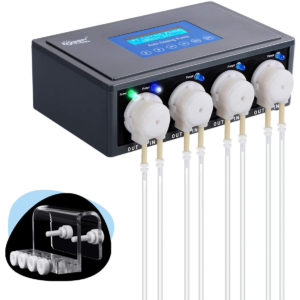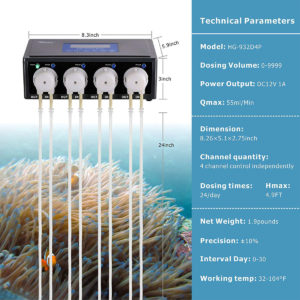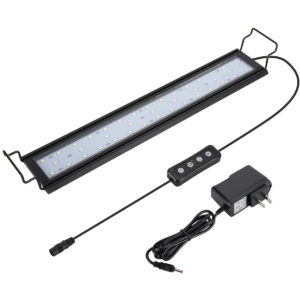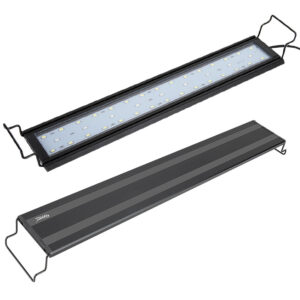Advice on Marine Algae in Coral Reef Tanks
Aside from the algae in freshwater aquariums, there are also marine algae in coral reef tanks. Being classified into beneficial and harmful algae, marine algae usually refer to those that grow in the sea or ocean, or on rocks at the edge of the sea or ocean. Some of them can be food sources. The marine algae we will discuss are those that grow in saltwater aquariums, like coral reef tanks. And today’s article will walk you through the marine algae in coral reefs and marine tanks.
Content Table
Marine algae types overview
There are a surprising number of marine algae, which can be unicellular or multicellular. Also, their color is varied from different pigments, such as chlorophyll A, chlorophyll B, and carotene. So, marine algae may come in green, green-yellow, brown, red, and golden. Next, given below, are some common marine algae.
- Brown algae (Phaeophyta): Brown algae, belonging to the phylum Phaeophyta, are one common multicellular marine algae. Generally, the algae are in brown or yellow-brown colors.
- Green algae (Chlorophyta): Green algae are common in home aquariums. They contain photosynthetic pigments, like chlorophyll A, chlorophyll B, and xanthophyll. Besides, the algae are food sources for some marine fish. Moreover, green algae require great water quality, bright light, and high calcium levels.
- Red algae (Rhodophyta): For the pigments phycoerythrin, phycocyanin, and chlorophyll A, red marine algae have vibrant colors. For example, Irish moss, Coralline, and Dulse. In general, red marine algae are demanding great water quality, intense light, and high calcium levels.
Benefits algae in coral reefs
Generally, marine algae play a role in filtering aquarium water and removing excess nutrients. While some also improve the ornamental value. This segment will share some beneficial algae in coral reefs.
1. Ulva (Sea Lettuce)
Sea lettuce belongs to green algae, which usually comes in green. Also, sea lettuce can be found on the surface of rocks or other algae. And it improves the ornamental value of your tank and lowers the nitrate and phosphate levels.
| Order | Ulvales | 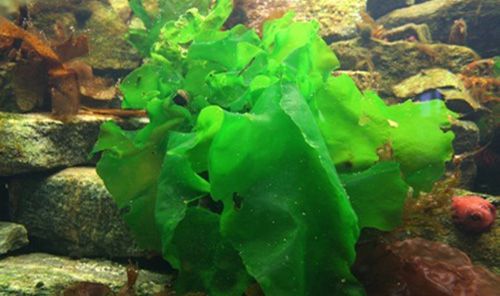 |
|
| Water temperature | 60-63℉ | ||
| pH level | 7.8-8.3 | ||
| Carbonate hardness | 8-10 dKH | ||
| Calcium level | 400-450 ppm | ||
| Phosphate level | less than 0.05 ppm | Nitrite level | 0 ppm |
| Ammonia level | 0 ppm | Nitrate level | no more than 10 ppm |
2. Coralline Algae
Coralline algae are red marine algae, which usually grow on rocks, stony corals, aquarium glass, or other objects’ surfaces. It will compete for the necessary nutrients with other harmful algae, and then limit harmful algae growth. Also, the algae are one food source for your aquarium, like Tangs, Parrotfish, and Limpets.
Then, how to keep coralline algae in your aquarium? Specifically, they require clean water with sufficient carbonates, calcium, and other trace minerals. However, high phosphate level will control their growth. Furthermore, they are photosynthetic organisms. Hence, you should have adequate light in your aquarium.
| Order | Corallinales | 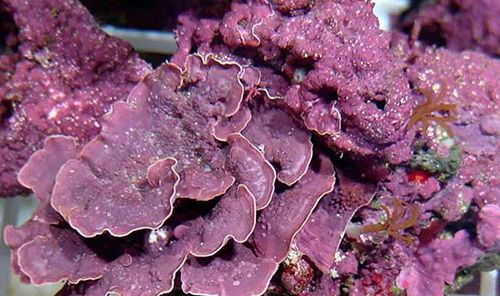 |
|
| Water temperature | 78-82℉ | ||
| pH level | 8.1-8.3 | ||
| Carbonate hardness | 7-10 dKH | ||
| Calcium level | 400-450 ppm | ||
| Phosphate level | less than 0.25 ppm | Nitrite level | 0 ppm |
| Ammonia level | 0 ppm | Nitrate level | less than 5 ppm |
3. Pom Pom Gracilaria
Pom pom gracilaria is macroalgae, which is hardy and grows fast. It helps to remove excess nutrients. Additionally, pom pom gracilaria is one food source for herbivores in marine aquariums. Nonetheless, you should supplement iron, magnesium, or other trace elements to keep it healthy in aquariums.
| Order | Gracilariales | 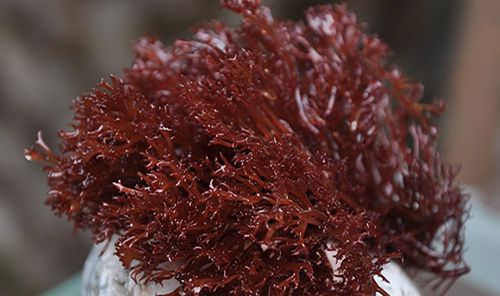 |
|
| Water temperature | 72-78℉ | ||
| pH level | 8.1-8.4 | ||
| Carbonate hardness | 8-12 dKH | ||
| Calcium level | 400-450 ppm | ||
| Phosphate level | less than 1 ppm | Nitrite level | 0 ppm |
| Ammonia level | 0 ppm | Nitrate level | less than 5 ppm |
On the other side, excessive algae may be damaging to your aquarium, As a result, sometimes you should control the algae growth. Here are some ways:
- Reduce the lighting hours: Algae need light to grow. Usually, you should keep the aquarium light on for about 10-12 hours. Lighting for a long time will lead to algae overgrowth.
- Decrease the nutrients for algae: With high nitrate and phosphate levels, some algae will grow fast in the aquarium. As a result, you’d better change the water regularly and maintain ideal water conditions. Also, do not overfeed.
- Introduce algae eaters: Algae eaters are those that can be fed on algae. There are many available alternatives, like turbo snails, tangs, dwarf angelfish, hermit crabs, and sea hares.
Harmful marine algae
Actually, not all algae are good for your marine aquariums. In this part, we will talk about some harmful marine algae.
- Bryopsis algae: It usually grows on rocks.
- Caulerpa algae: It grows on rocks and corals.
- Cyanobacteria: It will kill coral and beneficial bacteria in your tank.
- Dinoflagellates: It is toxic and fatal for low-lying snails.
- Valonia (Bubble algae): It always grows in clumps on rocks and corals.
In general, some algae can be removed manually. Besides that, most algae can be removed with an algae scrubber. It is a convenient magnetic cleaner, which helps to clean the tank without wetting your hands. Also, the aquarium cleaner tool kit is effective. Moreover, in the case of excessive nutrients, just change the water and clean the aquarium supplies.
By the way, here are some tips to prevent your tank from harmful algae.
- Keep ideal water parameters: Reducing the nitrate and phosphate levels is helpful to prevent algae growth. For example, bryopsis algae. Accordingly, change the water regularly and monitor the water parameters. For instance, change 30-50 percent of water once each week.
- Keep everything clean: algae spores or algae may get in by attaching to the creatures or equipment you add to the fish tank. Before introducing the fish to your aquarium, it is recommended to quarantine it in another tank. It provides an observation period to check whether there are algae spores on the fish’s body. Also, it helps to reduce disease infection. On the other side, you should also clean the aquarium regularly, especially the tank corners.
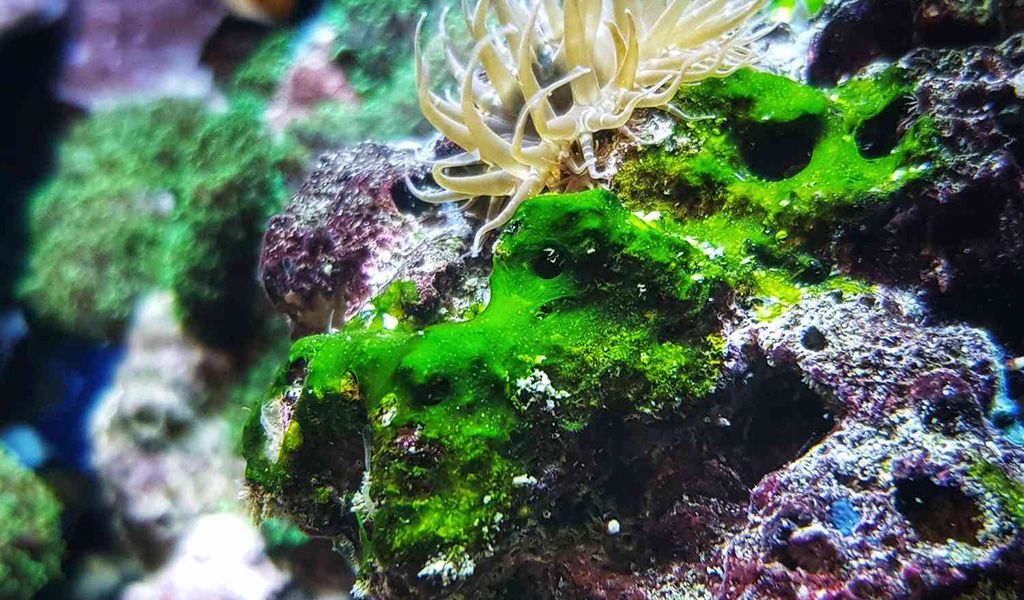
What would happen if there were no algae in the marine tank
Generally, if you do not grow algae at the beginning of setting up a new tank, your aquarium would suffer poor water quality, and even lead to algae thriving after introducing fish or other invertebrates.
Specifically, marine algae are one key part of saltwater aquariums. Then, why should we grow algae in a tank? First of all, let’s talk about “Refugium“, which means a safe area to protect fish, invertebrates, or algae from damage. It improves the biodiversity in aquariums. Besides that, marine algae make sense in maintaining great water quality. Because the algae consume nitrite, nitrate, phosphate, or other trace elements, and it helps to reduce excess nutrients. While the algae also filter aquarium water to keep great water quality. Furthermore, marine algae provide hiding places and food sources for fish and other invertebrates.
Additionally, though marine algae bring a handful of benefits to your aquarium, sometimes you do not want to grow them when setting up a new tank. Exactly, there are other ways. For instance, purchase the live rocks with algae from other aquarists or aquarium stores.

